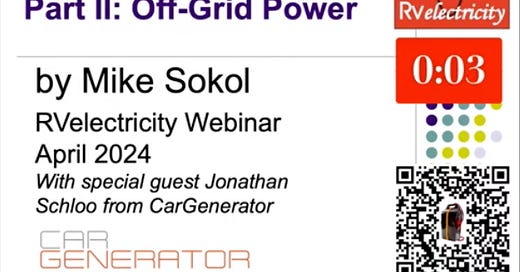Everyone,
I had a great time yesterday with special guest Jonathan Schloo from CarGenerator for our “Boondocking Without a Generator” webinar. The basic presentation was 40 minutes, but then Jonathan and I answered your online questions for another 40 minutes. Wow! You have a lot of questions.
Watch the rerun HERE
CarGenerator Deal
You can save hundreds of dollars on CarGenerator products plus get a 5 year extended warranty during the month of April by clicking HERE.
Any Questions?
This live interactive webinar covered the following topics:
Please watch the webcast and ask any questions in the comments.
Lithium battery upgrades - how much power do I need?
DC to DC chargers
Solar Generators and CarGenerator alternatives
Getting DC and AC power from your vehicle safely
DC and residential fridges power draw
Solar power limitations, pros and cons
How to accurately measure your off-grid power needs
New Hybrid power inverters
Dozens of your own questions…
Let’s play safe out there… Mike






I just thought to share a comment on alternators producing higher output at idle than normal. Higher internal heat can be generated at idle and some alternators can overheat at idle since the internal cooling fan(s) are turning more slowly. Likely less of an issue with diesel engines at idle that generally do not operate at as high of an RPM as gas engines when traveling on the highway where pulley sizes may vary affecting alternator RPM’s. Although we had to upsize some diesel-powered forest service type vehicle alternators to large case 200-amp bus alternators to withstand the heat of electrical loads and constant idling in the field. And our patrol car alternators in my career suffered shorter life spans due to high current loads and long idle hours, we referred to them as toasters, as many toasters operated at 1,000 watts. My experience is not meant to detract from any product or method of power production, only to share field experience of my automotive career.
Just thought there may be interest in this. We have a 2018 Tiffin Allegro Bus AP40 with a Cummins 450 HP diesel engine. It is an all electric coach with a residential refrigerator. I wanted a faster way to charge our 810 Ah lithium battery bank while driving. I designed and just installed a new single alternator charging system that automatically disconnects the starting batteries from the alternator and connects them to a DC-DC charger after the engine is started. The new alternator / programmable regulator is then free to charge only the lithium house batteries and power any other active DC loads, while driving down the road. It charges at 14.5 Volts, a charge current of around 300 Amps and brings the batteries back to 100% state of charge (SOC) and zero amp hours consumed as shown on the Victron 712S monitor. It takes less than one and a half hours to recharge the battery from a 50% SOC (405 Ah consumed) to 100% SOC when on the road. The system required designing and building a special controller system which interfaces with the Spyder Controls multiplex networking system. We are currently on a trip from Washington state and now in Arizona, and it is working flawlessly.